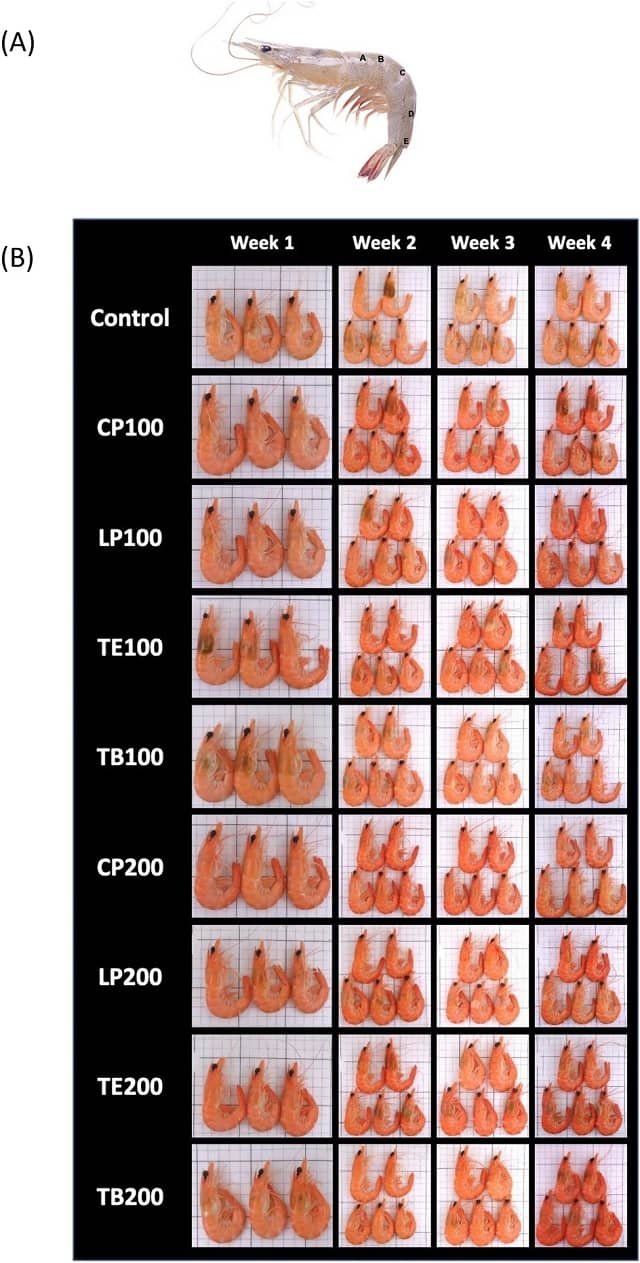Enhancing the immune status of shrimp through the addition of immunostimulants is a technique with great potential. The use of immunostimulants improves growth, immune system responses, and resistance to infections in shrimp.
In this regard, a recent study has shed light on the promising benefits of incorporating Chlorella vulgaris into the diet of white shrimp (Litopenaeus vannamei).
A team of scientists from Arish University, University of Jeddah, Suez Canal University, Port Said University, Universiti Islam Sultan Sharif Ali, King Abdulaziz University, Labor University, and Ghent University explored the impact of different concentrations of C. vulgaris on key parameters such as growth performance, feed consumption, body composition, and immune response in white shrimp (Litopenaeus vannamei) against Vibrio parahaemolyticus infection.
Experimental Setup
The 56-day study involved dividing a population of shrimp (initial weight 4.00 ± 0.04 g) into five groups, each consisting of 20 individuals and repeated three times.
Shrimp were raised in 15 hapas (1 m3 systems), and five different experimental diets with varying concentrations of C. vulgaris (0, 15, 20, 25, and 30 g/kg of feed) were administered. All diets contained at least 39% protein and 11% lipids.
Additionally, scientists conducted a challenge test at the end of the feeding trial. The experiment’s shrimp were challenged against a pathogenic strain of V. parahaemolyticus.
Growth Performance and Feed Utilization
Results revealed a significant increase in growth performance, feed utilization, and biomass in shrimp fed with higher concentrations of C. vulgaris (P < 0.05). This discovery opens new avenues for optimizing shrimp aquaculture practices, enhancing productivity, and resource utilization.
According to the study results, the inclusion of different concentrations of dry Chlorella vulgaris powder in shrimp feeds improved growth performance and feed utilization in vannamei shrimp.
Stay Always Informed
Join our communities to instantly receive the most important news, reports, and analysis from the aquaculture industry.
“Compared to all feeding treatments tested in the present study, nutritional supplements of 30 g/kg C. vulgaris significantly improved the growth performance and feed consumption of the investigated shrimp in this research,” report the researchers.
Information on Body Composition
Analysis of body composition, including protein, lipids, and ash content, further corroborated the positive effects of diets enriched with C. vulgaris.
Shrimp fed with higher concentrations showed a notable improvement, emphasizing the potential of Chlorella vulgaris as a nutritional supplement in shrimp aquaculture feeds.
Immune Response and Disease Resistance
One of the most significant findings was the enhanced immune response observed in shrimp fed with C. vulgaris. Antioxidant activity, a key indicator of immune system strength, showed a significant increase (P < 0.05) in shrimp fed with varying concentrations of C. vulgaris.
In particular, shrimp fed with a concentration of 30 g/kg of C. vulgaris demonstrated the highest disease resistance against Vibrio parahaemolyticus, highlighting the fundamental role of Chlorella vulgaris in reinforcing shrimp defense mechanisms.
According to the researchers, “Improved immunity can be attributed to the interaction between Chlorella cells and beneficial intestinal bacteria that can increase the activity of helpful bacteria in the digestive system and their contribution to the production of organic acids.”
Implications for Shrimp Aquaculture
The implications of this study are far-reaching. The incorporation of Chlorella vulgaris into shrimp diets has the potential to revolutionize aquaculture practices, offering a sustainable solution to improve growth, feed utilization, and immune responses.
The increased disease resistance observed in shrimp fed with C. vulgaris suggests its role not only in enhancing productivity but also in ensuring the long-term health and resilience of cultivated shrimp populations.
Conclusion
In conclusion, this study highlights the multifaceted benefits of Chlorella vulgaris in enhancing the overall performance and health of white shrimp in aquaculture environments.
“Supplementation with C. vulgaris in shrimp feed showed the highest growth, survival rate, body composition, immune responses, and shrimp tissue improvement. Maximum results were obtained in diets with a high concentration of Chlorella,” concluded the scientists.
They recommend applying dry Chlorella vulgaris powder to the diet at 25 g/kg of shrimp feed.
As the aquaculture industry seeks sustainable and efficient solutions, the inclusion of C. vulgaris in shrimp diets emerges as a promising path. Further research and widespread adoption of this innovative approach could significantly contribute to advancing shrimp farming practices, ensuring a healthier and more robust aquaculture industry in the future.”
Contact
El-Sayed Hemdan Eissa
Fish Research Centre, Arish University
El-Arish, 45511, Egypt
Contact: sayedhemd@gmail.com
Mohammad Bodrul Munir
Faculty of Agriculture, Universiti Islam Sultan Sharif Ali
Sinaut Campus, Tutong, TB1741, Brunei Darussalam
Contact hsjewel730@yahoo.com
Reference (open access)
Eissa, ES.H., Aljarari, R.M., Elfeky, A. et al. Protective effects of Chlorella vulgaris as a feed additive on growth performance, immunity, histopathology, and disease resistance against Vibrio parahaemolyticus in the Pacific white shrimp. Aquacult Int (2023). https://doi.org/10.1007/s10499-023-01298-y
Editor at the digital magazine AquaHoy. He holds a degree in Aquaculture Biology from the National University of Santa (UNS) and a Master’s degree in Science and Innovation Management from the Polytechnic University of Valencia, with postgraduate diplomas in Business Innovation and Innovation Management. He possesses extensive experience in the aquaculture and fisheries sector, having led the Fisheries Innovation Unit of the National Program for Innovation in Fisheries and Aquaculture (PNIPA). He has served as a senior consultant in technology watch, an innovation project formulator and advisor, and a lecturer at UNS. He is a member of the Peruvian College of Biologists and was recognized by the World Aquaculture Society (WAS) in 2016 for his contribution to aquaculture.



